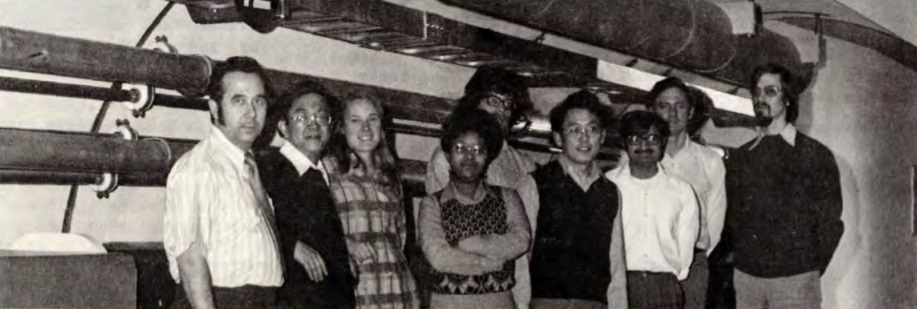B. Lee Heads NAL Theory Group

...NAL theoretical physicists in Village offices: (L-R) A. Pagnamenta, B. W. Lee, Mary Gaillard, S. Jackson, R. Savit, A. Sanda, S. Joglekar, J. Bronzan , J. Bartels...
The appointment of Benjamin W. Lee as head of the Theoretical Physics Group at NAL marks one step in the plan to strengthen that group to assume a major role at the Laboratory. "It is a sign of evolution of the Laboratory," says Dr. Lee. "Some of the experiments have reached a second generation; they have finished their 'survey' period; they are ready to go forward, frequently seeking ideas from a good, versatile theory group."
Dr. Lee comes to NAL from the State University of New York at Stony Brook. For 15 years he has worked at such places as the Princeton Institute for Advanced Study, the University of Pennsylvania, and Cal Tech, and has been associated with major high energy physics institutions and laboratories in the U.S. and in Europe. He and his wife and their two children live in Glen Ellyn.
NAL's Theoretical Physics group currently consists of Dr. Lee and six other physicists. They are Henry D. I . Abarbanel, Martin B. Einhorn, Stephen Ellis, Shirley Jackson, Emmanuel Paschos, Anthony Sanda, and Roberc Savit. Five visiting physicists are also part of the Theory Group: Jochen Bartels (from the University of Hamburg); John B. Bronzan, Rutgers University; Mary K. Gaillard, CERN; Satish Joglekar, Stony Brook; and Alan R. White, CERN. The group is relatively young, but its members are steeped in the most current knowledge and thinking about elementary particle physics. They may be specialists in one of several aspects of physics. The structure of the group remains flexible and open-ended, allowing for further build-up as well as for short term visits from theorists with interests that would benefit from a stay at NAL and from others who may have some special ideas which they wish to inject into the NAL research program.
This intellectual powerhouse interfaces with NAL activity in several ways. Many experiments in high energy physics test postulates or hypotheses which have been advanced in the high energy physics community by "theorists." Such theories often pique the interests of "experimenters" who then devise ways to test them. And progress comes from this interaction: experimental results -> theory -> more experiments -> advanced theory -> further experiments. Each element advances as a result of the activity of the other element.
At NAL, where scientists are exploring the outer edge of what is known in high energy physics and are peering into depths never before explored, the Theoretical Physics group will frequently be called on to chart the course for the voyage. Theoretical Physics generally does not analyze experimental data. Rather, it guides the thinking of experimenters, pointing out to them the most important aspects of their results, and indicating interesting new directions to probe.
Theorists visit experiments frequently, and become sounding boards, answering questions, prodding thinking. Fundamental to this interaction is an active program of joint seminars arranged both by experimenters and theorists. At such seminars exchanges are lively and fruitful. These seminars attract other outside theorists who bring their own stimulating insights.
"But most important of all," says Dr. Lee, "we theorists must act as good examples. We must contribute to intellectual leadership. And we must help with long range planning so that the Laboratory will always be in a pioneering position. The present research program is the result of that kind of planning, and we must continue."


